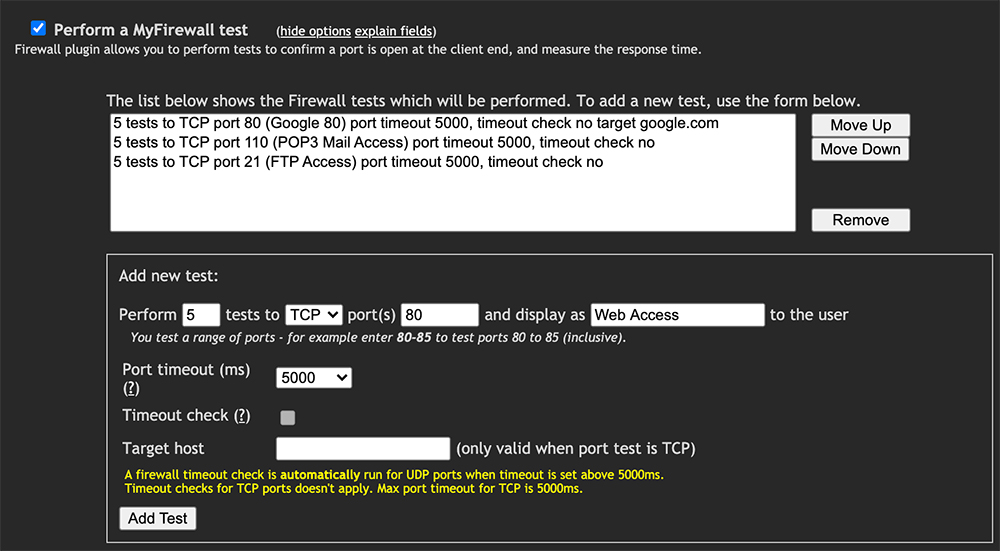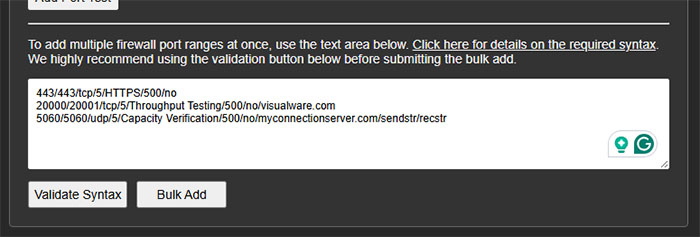
The list of ports to test shown initially are standard tests provided as an example, they can be removed. To do this simply select one with your mouse and click the Remove button.
Perform: Define the number of test needed for the test. It is important to define more than one test for UDP port test because packets are not recovered when dropped.
Protocol: Select either TCP or UDP for the firewall test. Note The firewall test is designed for MyConnection Server only, if you are testing a UDP port that is in use by another application on the MyConnection Server platform then the UDP test will likely fail. This is because the application may not return a response to the test request.
Ports: Enter the port number or ranges required for the firewall test. Note if a large range of test ports are defined and the 'perform count' is high then the firewall test can be a lengthy test, especially if ports timeout as timeouts are lengthy by default.
Display name: Enter the display name required for the test. The display name appears in the client user interface and also the database reports.
Port Timeout: Values 5000ms and below set the max wait time before the port is reported as blocked. Lower values improve runtime but can cause a false result, Values 10000ms and above enables the port timeout check.
Timeout Check: Automatically set for port timeout values 10000ms and above. When checked, this option, will ensure open ports stay open for time selected. Ports that close too soon are reported as blocked.
Target: To test a server other than MCS, enter its address here.
When setting a target for a UDP port, you must also specify both a send string and a receive string. This is because UDP communication is usually one-way. MCS needs to know what data the destination port expects to receive and what response it will send back. This allows MCS to confirm that the port has responded and is therefore open.
Click Add Test button to add the configured ports to be tested.
Notes: A Firewall test can test any number of ports and ports ranges however the test length can be material as a result. Use the 'move' buttons to reorder the test definitions when there are more than one.
This feature is available in MCS version 11.3g and later.
When a large number of ports must be tested and they cannot be defined as a continuous range, the Bulk Add feature allows all ports to be entered efficiently in a single operation.

The syntax for defining ports in bulk is outlined below.
Each port definition is entered on a separate line within the text area shown in Figure 2. Parameters are separated by a forward slash (/). Refer to the notes section below the table for additional details and exceptions.
| Index | Name | Description | Validation | Example |
|---|---|---|---|---|
| 1 | Low Port | The lowest port number in the range to test. | Must be a number between 1 and 65535. | 80 |
| 2 | High Port | The highest port number in the range to test. | Must be a number between 1 and 65535. | 81 |
| 3 | Protocol | The communication protocol used by the port. | Must be either tcp or udp. |
udp |
| 4 | Tests | The number of test attempts to perform on the destination port. | Must be between 1 and 30. | 5 |
| 5 | Label | A descriptive label indicating the purpose of the port being tested. | Maximum 100 characters. | SFTP |
| 6 | Timeout | The maximum wait time (in milliseconds) before the port is reported as blocked. | Minimum: 500. Maximum: 120000. For TCP, the maximum is 5000. | 500 |
| 7 | Timeout Check | Specifies whether open ports must remain open for the defined duration. | Must be set to yes or no. |
no |
| 8* | Target | The IP address or domain name of the destination host used for testing port availability. | Must be a valid IP address or domain name. | visualware.com |
| 9* | Send String | For UDP ports, defines the data to be sent to the destination port. | Required only for UDP tests with a defined target. | send |
| 10* | Receive String | For UDP ports, defines the data expected in response from the destination port. | Required only for UDP tests with a defined target. | receive |
* Target, Send String, and Receive String are optional. If not required, they should be omitted from the port definition.
The examples below illustrate valid syntax combinations:
443/443/tcp/5/HTTPS/500/no
20000/20001/tcp/5/Throughput Testing/500/no/visualware.com
5060/5060/udp/5/Capacity Verification/500/no/myconnectionserver.com/sendstr/recstr
Before selecting the